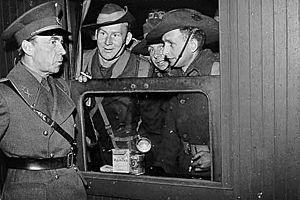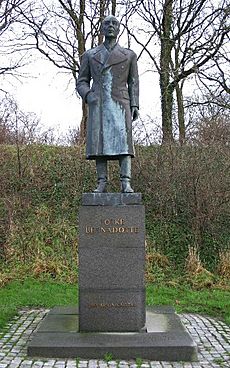Folke Bernadotte facts for kids
Quick facts for kids Folke Bernadotte |
|
|---|---|
| Count of Wisborg | |
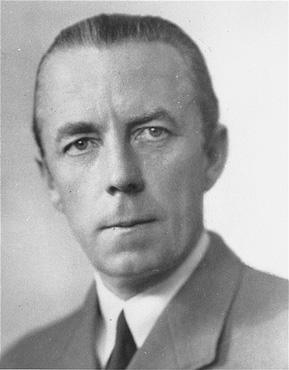
Bernadotte in the mid 1940s
|
|
| Born | 2 January 1895 Stockholm, Sweden |
| Died | 17 September 1948 (aged 53) Jerusalem, Israel |
| Burial | Northern Cemetery, Solna |
| Spouse |
Estelle Romaine Manville
(m. 1928) |
| Issue |
|
| House | Bernadotte |
| Father | Prince Oscar Bernadotte |
| Mother | Ebba Munck af Fulkila |
Folke Bernadotte, Count of Wisborg (born January 2, 1895 – died September 17, 1948) was a Swedish nobleman and diplomat. He is remembered for his important work during and after World War II.
During the war, he helped free many prisoners from German concentration camps. He also tried to negotiate peace between Germany and the Allied forces. After the war, the United Nations Security Council chose him to help bring peace in the Arab–Israeli conflict of 1947–1948.
Sadly, he was killed in Jerusalem in 1948 while working for peace. After his death, Ralph Bunche continued his work at the UN. Bunche successfully helped create peace agreements between Israel and Egypt.
Contents
Early Life and Work
Folke Bernadotte was born in Stockholm, Sweden. His family, the House of Bernadotte, was the Swedish royal family. His father was Prince Oscar Bernadotte.
Folke went to school in Stockholm. Then, he trained to become a cavalry officer at the Royal Military Academy. He became a lieutenant in 1918 and later a major.
Bernadotte represented Sweden at important events. These included the Chicago Century of Progress Exposition in 1933. He also served at the New York World's Fair in 1939–40.
He was very involved with the Swedish Boy Scouts. He became the director of the organization in 1937. When World War II started, Bernadotte helped the scouts prepare. They trained for anti-aircraft work and as medical assistants. In 1943, Bernadotte became the Vice Chairman of the Swedish Red Cross.
Helping During World War II
During 1943 and 1944, Bernadotte organized prisoner exchanges. These efforts brought 11,000 prisoners from Germany back home to Sweden. As Vice-President of the Swedish Red Cross in 1945, he led several rescue missions in Germany.
In April 1945, Heinrich Himmler, a high-ranking German official, asked Bernadotte for help. Himmler wanted Bernadotte to offer a peace deal to Winston Churchill and Harry S. Truman. This offer was made without Adolf Hitler's knowledge. Himmler wanted Germany to surrender only to the Western Allies. He hoped they could keep fighting the Soviet Union. Bernadotte told Himmler the offer would not be accepted. Still, he passed it on to the Swedish government and the Western Allies. The offer did not lead to peace.
The White Buses Mission
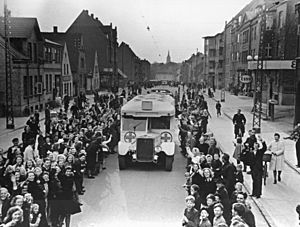
In the last months of the war, Bernadotte helped with a rescue operation. This mission transported prisoners from German concentration camps to hospitals in Sweden. These prisoners included Norwegians, Danes, and other Western Europeans.
In spring 1945, Bernadotte met Heinrich Himmler in Germany. Bernadotte's main goal was to rescue Norwegian and Danish POWs. He returned to Sweden on May 1, 1945. This was the day after Hitler's death. A Swedish newspaper reported that Bernadotte rescued 15,000 people. This included about 8,000 Danes and Norwegians. It also included 7,000 women from France, Poland, and other countries. The missions were dangerous for the Swedish Red Cross staff. They faced political challenges and Allied bombings.
The mission became famous for its special buses. These buses were painted completely white. They had the Red Cross symbol on the side. This was to make sure they were not mistaken for military targets. The mission involved 308 people, including medics and volunteer soldiers. They used 36 hospital buses, 19 trucks, and other vehicles. They also carried all their own supplies, like food and gasoline. They were not allowed to get supplies in Germany.
In total, about 21,000 people were rescued. This included 8,000 Danes and Norwegians. It also included 5,911 Poles, 2,629 French, 1,615 Jews, and 1,124 Germans. After Germany surrendered, the White Buses mission continued. In May and June, about 10,000 more freed prisoners were evacuated.
Bernadotte wrote a book about the White Buses mission. It was called The End. My Humanitarian Negotiations in Germany in 1945 and Their Political Consequences. It was published in Swedish on June 15, 1945.
UN Mediator for Peace
On May 20, 1948, Folke Bernadotte was chosen for a new role. He became the "United Nations Mediator in Palestine." This was the first official mediation in the UN's history. It was needed because of fighting after the United Nations Partition Plan for Palestine. This plan divided Palestine and led to the Israeli Declaration of Independence.
In this role, Bernadotte helped achieve a first truce. This was during the 1948 Arab–Israeli War. He also started the work for the United Nations Relief and Works Agency for Palestine Refugees in the Near East. This agency helps refugees.
Bernadotte understood that solving the problem was complex. He wrote that any plan must consider many things. These included the hopes of the Jewish people. It also included the views of Arab leaders. He also thought about the interests of Great Britain and the United States. Finally, he considered the authority of the United Nations.
After Bernadotte's death, his assistant, Ralph Bunche, took over. Bunche successfully negotiated a ceasefire. This was signed on the Greek island of Rhodes. These agreements are known as the 1949 Armistice Agreements.
Assassination
Folke Bernadotte was killed on September 17, 1948. He was assassinated by members of a group called Lehi. This group was also known as the Stern Gang. They were a Zionist group.
Lehi saw Bernadotte as a threat to the new State of Israel. They worried that the Israeli leaders would agree to his peace plans. Lehi thought these plans would be bad for Israel. The group did not know that the Israeli government had already decided to reject Bernadotte's plan.
The killing was approved by three leaders of Lehi. These included Yitzhak Yezernitsky, who later became Prime Minister of Israel Yitzhak Shamir.
The Attack
A team of four men planned the attack. They set up a roadblock in Jerusalem. When Bernadotte's car approached, one man, Yehoshua Cohen, fired shots into Bernadotte's car. Bernadotte was hit and died. Colonel André Serot, who was with him, was also killed. Serot had changed seats to thank Bernadotte for saving his wife in a concentration camp.
After the shooting, Bernadotte's car rushed to the hospital. But it was too late. He was pronounced dead. General Åge Lundström, who was in the car, described the attack. He said a man put a gun through the car window and fired.
All four attackers escaped and hid. They later fled to Tel Aviv.
Investigation and Aftermath
At first, Lehi leaders denied they were responsible. Later, Lehi claimed responsibility for the killings.
Lehi was disarmed, and many members were arrested. However, no one was charged with the murders. The police investigation did not find the people who took part in the assassination. Some believe this was due to poor teamwork between different police groups. Also, police officers were not very experienced at that time.
Years later, the role of Yehoshua Cohen was discovered. He was working as David Ben-Gurion's personal bodyguard. In 1977, Lehi publicly admitted their role in the killing. The time limit for prosecuting the murder had passed in 1971. In 1988, two of the attackers confessed their roles. They confirmed that Cohen had killed Bernadotte.
The gun used in the assassination was lost for many years. It was found again in 2018 during an inventory check.
Diplomatic Impact
The day after the murders, the United Nations Security Council condemned the killing. They called it "a cowardly act" by "a criminal group of terrorists."
The Swedish government believed Bernadotte was killed by Israeli agents. They criticized the Israeli investigation. They also tried to delay Israel's entry into the United Nations, but this was not successful. In 1950, Sweden recognized Israel. But relations remained cool for a while.
Ralph Bunche, Bernadotte's American deputy, took over as UN mediator. Bunche successfully helped create the 1949 Armistice Agreements. For this work, he received the Nobel Peace Prize.
Awards and Memorials
In 1998, Bernadotte received a special award. It was one of the first Dag Hammarskjöld Medals. This medal is given to UN peacekeepers who die while on duty.
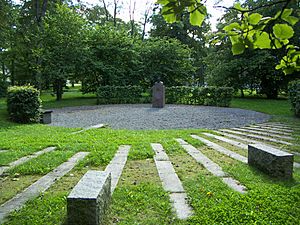
The university library at Gustavus Adolphus College in St. Peter, Minnesota, US, is named after him.
Family Life
In 1928, Folke Bernadotte married Estelle Romaine Manville in New York. Her family founded part of the Johns-Manville Corporation.
They had four sons. Two of their sons died when they were children.
- Count Gustaf Eduard Bernadotte of Wisborg (1930–1936)
- Count Folke Bernadotte of Wisborg (born 1931)
- Count Fredrik Oscar Bernadotte of Wisborg (1934–1944)
- Count Bertil Oscar Bernadotte of Wisborg (born 1935)
His widow, Estelle Bernadotte, remarried in 1973. All seven of his grandchildren were born after his death.
Books
- The End. My Humanitarian Negotiations in Germany in 1945 and Their Political Consequences (Swedish title: Slutet.)
See also
 In Spanish: Folke Bernadotte para niños
In Spanish: Folke Bernadotte para niños


